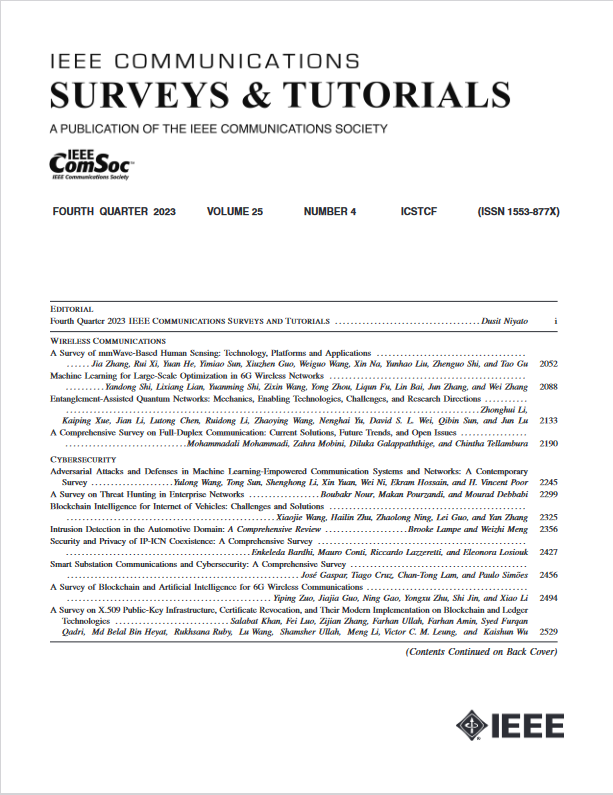面向主动网络安全防御的网络威胁情报挖掘:综述与新视角
IF 34.4
1区 计算机科学
Q1 COMPUTER SCIENCE, INFORMATION SYSTEMS
引用次数: 5
摘要
今天的网络攻击变得更加严重和频繁,这需要新的安全防御线来保护它们。新一代威胁具有规避性、弹性和复杂性的动态特性,使得基于启发式和签名的传统安全系统难以匹配。组织的目标是收集和共享实时网络威胁信息,然后将其转化为威胁情报,以防止攻击,或者至少以主动的方式快速响应。网络威胁情报(CTI)挖掘是一种发现、处理和分析有关网络威胁的有价值信息的技术,正在蓬勃发展。然而,今天大多数组织主要关注基本用例,例如将威胁数据源与现有的网络和防火墙系统、入侵防御系统以及安全信息和事件管理系统(SIEMs)集成,而没有利用这种新智能可以提供的洞察力。为了充分利用CTI以显著加强安全态势,我们在本文中全面回顾了最近从多个数据源中对CTI挖掘的研究成果。具体来说,我们提供并设计了一个分类法,根据预期目的(即,与网络安全相关的实体和事件,网络攻击战术,技术和程序,黑客概况,妥协指标,漏洞利用和恶意软件实施,以及威胁狩猎)总结CTI挖掘的研究,以及对当前最新技术的全面回顾。最后,我们讨论了CTI挖掘的研究挑战和未来可能的研究方向。本文章由计算机程序翻译,如有差异,请以英文原文为准。
Cyber Threat Intelligence Mining for Proactive Cybersecurity Defense: A Survey and New Perspectives
Today’s cyber attacks have become more severe and frequent, which calls for a new line of security defenses to protect against them. The dynamic nature of new-generation threats, which are evasive, resilient, and complex, makes traditional security systems based on heuristics and signatures struggle to match. Organizations aim to gather and share real-time cyber threat information and then turn it into threat intelligence for preventing attacks or, at the very least, responding quickly in a proactive manner. Cyber Threat Intelligence (CTI) mining, which uncovers, processes, and analyzes valuable information about cyber threats, is booming. However, most organizations today mainly focus on basic use cases, such as integrating threat data feeds with existing network and firewall systems, intrusion prevention systems, and Security Information and Event Management systems (SIEMs), without taking advantage of the insights that such new intelligence can deliver. In order to make the most of CTI so as to significantly strengthen security postures, we present a comprehensive review of recent research efforts on CTI mining from multiple data sources in this article. Specifically, we provide and devise a taxonomy to summarize the studies on CTI mining based on the intended purposes (i.e., cybersecurity-related entities and events, cyber attack tactics, techniques and procedures, profiles of hackers, indicators of compromise, vulnerability exploits and malware implementation, and threat hunting), along with a comprehensive review of the current state-of-the-art. Lastly, we discuss research challenges and possible future research directions for CTI mining.
求助全文
通过发布文献求助,成功后即可免费获取论文全文。
去求助
来源期刊

IEEE Communications Surveys and Tutorials
COMPUTER SCIENCE, INFORMATION SYSTEMS-TELECOMMUNICATIONS
CiteScore
80.20
自引率
2.50%
发文量
84
审稿时长
6 months
期刊介绍:
IEEE Communications Surveys & Tutorials is an online journal published by the IEEE Communications Society for tutorials and surveys covering all aspects of the communications field. Telecommunications technology is progressing at a rapid pace, and the IEEE Communications Society is committed to providing researchers and other professionals the information and tools to stay abreast. IEEE Communications Surveys and Tutorials focuses on integrating and adding understanding to the existing literature on communications, putting results in context. Whether searching for in-depth information about a familiar area or an introduction into a new area, IEEE Communications Surveys & Tutorials aims to be the premier source of peer-reviewed, comprehensive tutorials and surveys, and pointers to further sources. IEEE Communications Surveys & Tutorials publishes only articles exclusively written for IEEE Communications Surveys & Tutorials and go through a rigorous review process before their publication in the quarterly issues.
A tutorial article in the IEEE Communications Surveys & Tutorials should be designed to help the reader to become familiar with and learn something specific about a chosen topic. In contrast, the term survey, as applied here, is defined to mean a survey of the literature. A survey article in IEEE Communications Surveys & Tutorials should provide a comprehensive review of developments in a selected area, covering its development from its inception to its current state and beyond, and illustrating its development through liberal citations from the literature. Both tutorials and surveys should be tutorial in nature and should be written in a style comprehensible to readers outside the specialty of the article.
 求助内容:
求助内容: 应助结果提醒方式:
应助结果提醒方式:


